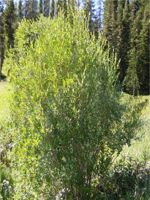Mon-Fri 9am - 5pm Mountain time
Bog Willow vs Bebbs Willow
Salix pedicellaris
Salix bebbiana
CUSTOM GROW
One of the most common willows in Canada. This shrubby willow is common in swampy, peaty, shorelines (bogs and fens). Rarely over 6 feet in height.
A great native species for reclamation or naturalization projects in riparian zones.
All willow are important to native pollinators each spring as they have higher amounts of pollen and nectar early each growing season when other food sources are scarce.
This large shrub is native to all of Canada and most of the United States. Its leaves are green on the top and grey on the bottom, and it produces catkin based flowers and non-edible fruit which appears very similar to a group of pine needles.
Bebb's Willow is foraged for by many species including elk, hares, beavers and various birds. It is commonly used to prevent erosion and protect aquatic environments due to its preference for shady, moist environments.

